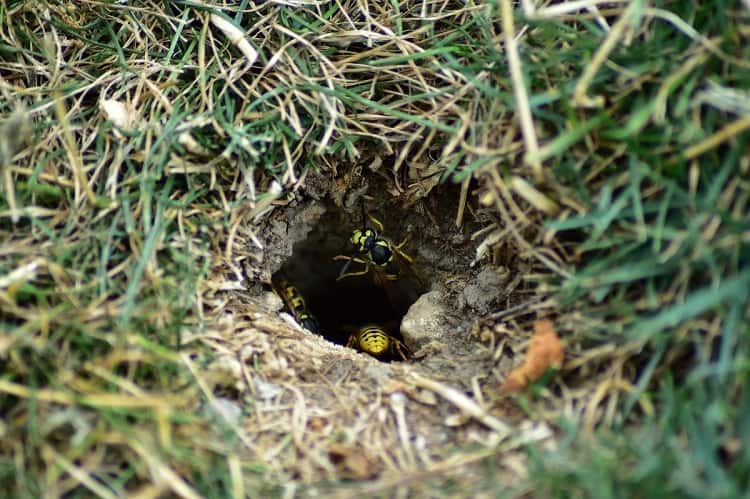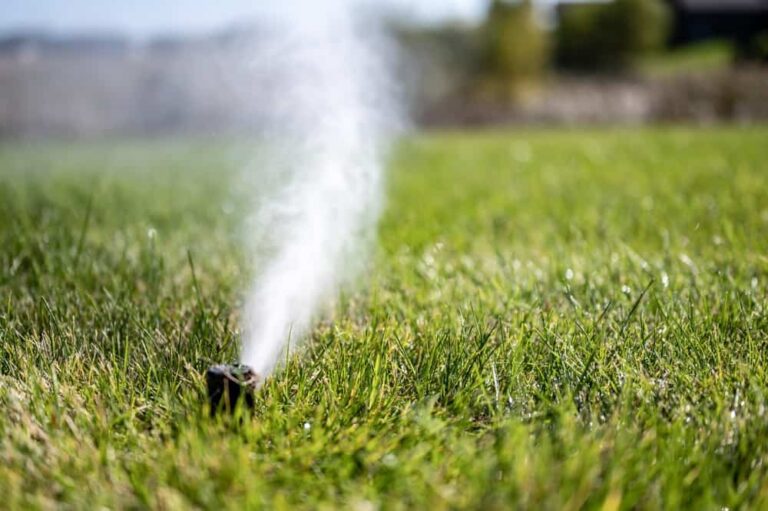How To Get Rid Of Ground Bees in 4 Easy Steps
There are several methods you can apply to rid your lawn of adult ground bees safely and effectively. To avoid bee stings or yellow jacket stings, you’ll want to ensure you know what you’re dealing with when around stinging insects. You’ve found the right place to learn how to get rid of ground bees!

Speaking of safety, let’s start by saying if you’re severely allergic to any known stinging insect, call in a pest control professional or brave, non allergic friend.
If not, let’s first understand these little creatures and their sometimes aggressive cousins known as wasps. What are they, and where are they found? What impact do they have on your garden, and how do you get rid of them yourself?
Table of Contents
Understanding Ground Bees
Identification
Ground bees, also known as mining bees or digger bees, are a group of solitary bees that primarily make their nests in the ground. They can be distinguished from other bees by their robust, furry appearance and smaller size. They are typically dull in color, ranging from black to brown, with or without yellow markings on their bodies.
One key characteristic of ground bees is their pollen-carrying structures, known as scopae. Unlike honey bees that carry pollen in their legs, they carry pollen in the dense hairs located on their abdomen or hind legs.
Habitat
Ground bees favor areas with well-drained, sandy, or loamy soil for their nesting sites. They often choose sunlit spots with sparse vegetation, as it allows them to easily access and maintain their burrows. You may spot their nesting sites by looking for small mounds of soil surrounding the entrance hole, which can be up to half an inch in diameter.
As solitary bees, ground bees do not form colonies like honey bees or bumblebees. Instead, each female bee digs her own burrow and provisions it with nectar and pollen for her offspring. However, it is not uncommon to find several ground bee burrows in close proximity, creating the appearance of a social community.
Life Cycle
The life cycle of ground bees consists of four stages: egg, larva, pupa, and adult. The female ground bee lays an egg on a pollen and nectar ball inside the brood cell of her burrow. The larva hatches, feeds on the provided pollen and nectar, and eventually pupates. The pupal stage can last from several weeks to months, depending on the species.
Adult ground bees emerge from the nest, mate, and forage for food. Females begin constructing new nesting sites, digging their burrows and packing them with provisions for their offspring. After laying eggs and provisioning the nest, the female ground bee dies, and the cycle begins anew.
What Type of Ground Bees Are Harmful to Your Garden (and You)?
Bees are an essential component of the ecosystem. They aerate your yard and are avid pollinators. Several varieties are considered species of ground bees, including: Mining bees, Masons, Sweat bees, Blueberry bees, and Leafcutters.
The distinguishing factor is their preferred habitat. Most honey bee species make waxy hives on structures like branches and fallen tree trunks, while ground bees live in underground tunnels.
But when they encroach on your living or working space, you may have to get rid of them. Sweat bees are the most annoying of the bunch because, as the name suggests, they are attracted to sweat and will buzz around you if they infest your yard.
If you see the following image, you’re dealing with yellow jackets, a type of wasp which is much more aggressive. They can fool you because the underground nests look similar. The same methods can apply for dealing with yellow jackets, but you need to use greater caution. Ground wasps are going to need greater planning and care to remove.

How to Spot An Underground Nest
Species of bees that nest and rest underneath the ground have isolated habitats or live in social colonies. For instance, bumble bees are colonial and are found in swarms, but you will often spot a solitary ground bee.
The first thing you should be on the lookout for is anything indicating the presence of ground bees in your garden. Typically, a couple of bees buzzing around the compound or hovering over a specific spot of the ground would strongly suggest a nest.
Ground bees prefer areas with sandy soil and dry soils. Thus, places with anthills and mounds of soil could be hotspots. Another critical difference between bumblebees and ground bees is that the latter excavates new homes each time they move; bumblebees will use burrows abandoned by rodents like rabbits and field rats.
Remember, if you spot multiple bees flying low and using a single hole to go into the ground, you are dealing with a colony. Therefore, you have to exercise extreme caution. And note that although ground bees are non-threatening, the females have a stinger and are ever prepared to defend their eggs and homes.
After you understand the scope of what you’re dealing with, you can begin looking at how to get rid of ground bees.
When to Get Rid of Bees in the Ground?
If you have children or pets who love playing in the yard, you should get rid of burrowing bees. This helps to minimize the chances of anyone developing an allergic reaction after getting stung.
They nest during spring. They are occasional visitors, and you may only see them within that season. Spring is, therefore, an opportune time to rid your grounds of bees.
How to Get Rid Of Ground Bees?
Natural methods
- The best natural method is ensuring the ground is damp to discourage the grounding bees from nesting.
- Cover the entrance to the underground nest using a brick or stones to block the female ground bees access to their eggs. Be sure to use protective clothing when approaching ground bee nests.
- Once you’ve covered the hole to the nest, use the bees attraction to sugary things and trap them in bottles. Just fill a bottle halfway with sweet soda. The ground bees will fly into the bottle and drown.
- Strong-smelling scents from plants like cucumbers, cinnamon, coffee grounds, and peppermint are natural deterrents. Sprinkling cinnamon on the holes will discourage the ground bees from building a nest on your grounds, as will spraying the entrance to the next with a mixture of peppermint oil, dish soap, and water.
- Simple DIY sprays like a vinegar spray made from mixing equal parts water and white vinegar.
Chemical solutions
Also available are top-quality pesticides that you can purchase from gardening or household stores. These pesticides are available in various forms, such as sprays, dust powders, and liquid form.
We would prefer not to recommend chemicals, especially if you have pets or young children, but we recognize that they are necessary in certain instances. Our recommendation would be to contact a local pest control company or resource that can properly apply these products. You can also purchase them from your local hardware store.
Step by Step Guide
Step 1: Identify the nesting grounds
You need to be certain that you are removing bees and not more aggressive insects like wasps. They will require additional preparation and caution. Utilize the techniques mentioned above to help you spot potential nesting grounds.
Remember, bees that burrow will prefer dry to damp soil, so look for mounds with loose soil concealing little holes on the ground’s surface.
Step 2: Select a method
Out of the numerous options available in the market, select one suitable method that works for you. Our recommendations are for the natural methods listed above as the least toxic pest control solution. These can be both safer and cheaper if there is not an unmanageable infestation.
Step 3: Wear protective clothing.
Though bees are less aggressive, you can still encounter aggressive ground bees. You could also mistakenly encounter a wasp. Better to be safe than sorry and wear long sleeves, pants tucked into your enclosed shoes, and gloves.
Step 4: Apply the treatment in the late afternoon or evening.
Ensure you are familiar with the right way to apply the extermination solution you choose. For instance, eco-friendly pesticides are applied around the entrance of the little burrow for maximum effect.
Doing so late in the day will ensure the least amount of activity.
After completing the steps, be Patient (particularly with natural methods)
If your methods are natural, it may take a few days or weeks to completely remove the ground bees. The population is seasonal, so you may need to repeat the process periodically.
When Should You Hire A Professional for Ground Bee Removal?

Take, say, you spot a nesting ground of bees near your living space but have no clue what to do or where to begin. You have tried searching online to get rid of ground bees, but you still lack the confidence to carry out the extermination via DIY.
Maybe the resources you require to carry out the job are unavailable or costly. Most people are faced with time constraints, which makes it challenging to perform the task yourself.
It’s essential to recognize when your efforts are not enough, and you need to rely on professional help. Some situations where calling an exterminator is needed include:
- Signs of a severe ground bee infestation, such as a large number of active nests.
- Frequent and aggressive bee attacks posing a threat to humans and pets.
- Multiple eradication attempts have been unsuccessful, and the problem persists.
- The presence of ground bees makes it difficult to use or maintain outdoor spaces.
If you are faced with any of the above issues, it may be time to call in the professionals. Expert pest controllers have the necessary experience and required tools to guarantee the safe removal of ground bees.
They are also well-updated on the most effective methods to keep your yard bee-free.
Selecting a Pest Control Company
Once you’ve decided to seek professional assistance, it’s crucial to choose a reputable pest control company. Keep these tips in mind when selecting a service provider:
| Research | Check online reviews, testimonials, and ask for recommendations from friends and family. |
|---|---|
| Experience | Verify that the company has experience dealing specifically with ground bees and their removal. |
| Licensing and Insurance | Ensure the company holds the necessary licenses and insurance to operate in your area. |
| Environmentally Friendly Methods | Discuss the methods they will use to remove the bees and opt for a company that prioritizes eco-friendly techniques that protect wildlife. |
Preventing Ground Bee Reinfestation
After successfully getting rid of ground bees, it’s essential to take preventative measures to avoid reinfestation. This final section will cover various strategies to keep them from returning to your yard. These techniques involve landscape maintenance, monitoring, and early detection.
Landscape Maintenance
Ground bees prefer dry soil for nesting. Keeping your landscape damp and well-maintained can discourage them from settling in your yard. Here are a few tips for landscape maintenance:
- Water your lawn regularly.
- Fill in any holes or depressions in your yard to eliminate potential nesting sites.
- Aerate your lawn to promote healthy root growth.
- Remove dead leaves, debris, and woodpiles that can attract ground bees.
Monitoring and Early Detection
Remaining vigilant and detecting ground bee activity early can minimize the impact of an infestation. Here’s what to look for:
- Observe your yard for signs of ground bees, such as small holes or mounds of soil near plants.
- Identify potential nesting sites and take appropriate measures to eliminate them.
- If you find an active ground bee nest, take prompt action to address the issue using proven techniques.
Implementing landscape maintenance and proactively monitoring your yard will help protect your property from ground bee reinfestation. Continuing these practices will ensure that your outdoor space remains safe and enjoyable for years to come.
Take Away
Burrowing bees are important to the ecosystem. However, if they are a nuisance, learning how to get rid of ground bees quickly and safely will make your yard amore pleasant place to be. As soon as you identify a nest, pick a preferred bee control solution, apply it, and wait for the ground bees to clear away.





